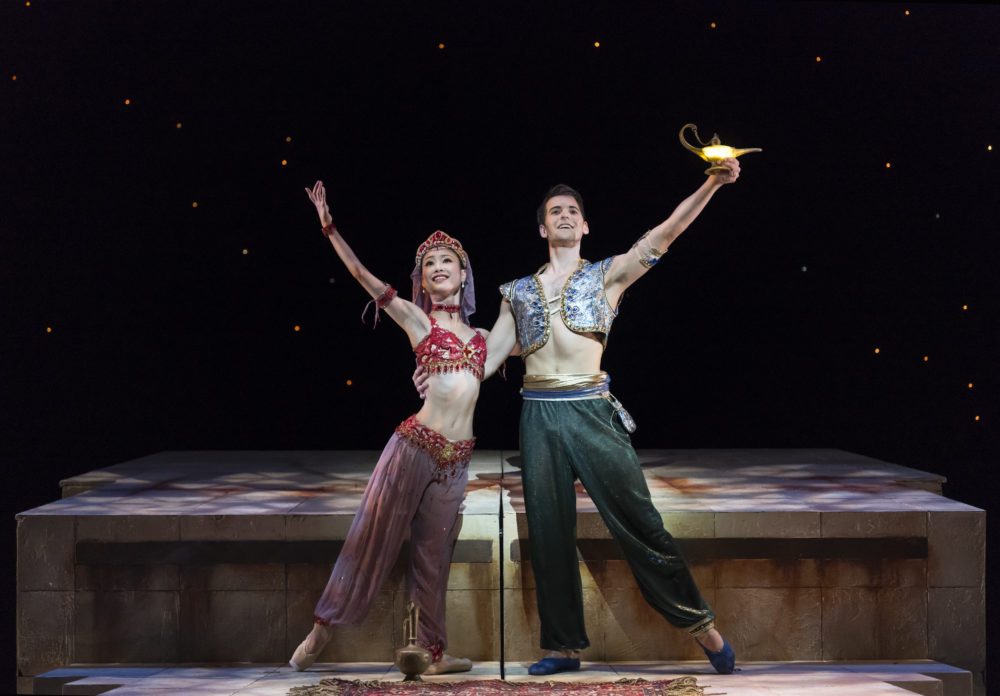The Birmingham Royal Ballet brings Aladdin to life in a colourful and lavish visual feast – with diaphanous costumes, magnificent sets and grand choreography, tracing the boy’s evolution from cheeky “street rat” to gallant prince, with the aid of a magical genie.
We meet Aladdin (Mathias Dingman) in the streets, below a lofty set of hanging Persian rugs. Here, he plays tricks on the pompous guards, lightly evading their menacing curved blades. The crowd gathers, following in his wake as he leaps across stage, taunting the officials. When he is finally caught, the Mahgrib (Valentine Olovyannikov – or Jaffar, in the Disney version) comes to the rescue.
Mathias plays a lovable Aladdin, full of comic youthful naiveté that makes the audience laugh, while performing the energetic choreography with ease.
Once Aladdin is freed, the mysterious Mahgrib escorts him through shifting desert sands. At the mouth of the Cave of Wonders, Aladdin descends alone. Stalactites glow, illuminating an abundance of treasure – from rubies to gold and diamonds.
The storyline is put on pause as the precious gems showcase their elegance in triumphant snippets, festooned in lustrous attire by customer Sue Blane. Celine Gittens is a resplendent diamond, with wonderful musicality, impressive flexibility giving a joyous performance. Celine shines extra bright among her sparkling gems, with tutus adorned with glittering jewels.
The Desert Winds and each of the gems, Onyx and Pearls, Sapphire, Rubies and Diamonds presented a unique quality to the choreography. Brandon Lawrence beams in Emeralds, with his commanding power and naturally lyrical movements, infused with his distinct pleasure of performing. Nao Sakuma and Tyrone Singleton lit up the stage with their dazzling Rubies pas de deux. Nao with her strength was equalled by Tyrone’s enthralling presence. Together they created breathtaking moments with Tyrone releasing Nao in mid-flight split jete above his head and performing incredible pirouettes that whisked fast and fantastic.
After taking a selection of these gems for himself, Aladdin eventually finds the lamp, which he uses to escape the cave after the Mahgrib seals him inside. He reappears by his incredulous mother (Marion Tate), animatedly recounting his tale through gestures. Her disbelief transforms into awe when she polishes the lamp to reveal the powerful Djinn, hovering in a shroud of mist, as treasures pour forth.
The immaculate production of Aladdin employs incredibly huge and detailed sets by Dick Bird, so the two 25-minute intermissions are rewarded with impressive scenery changes. The second act, which features the emerging love story between the exquisite, doe-like Princess Badr al-Budur (Momoko Hirata), opens in the women’s bathhouse. Steam flits through Moorish keyhole arches, water spilling from taps, as the attendants pamper and perfume the princess in a feminine and refined cleansing ritual.
Whereas Aladdin projects his exuberant love throughout his entire body, the wisplike Princess Badr al-Budur coyly accepts his advances – until a bath-goer spies him and dramatically reports his offence to the Sultan. The decree: off with his head!
Momoko and Mathias are a lovely match, she’s elegant and as light as a feather and he’s playful and bold creating a wonderful balance that shows through their pas de deux. And upon facing death Momoko is deeply distraught, while Mathias remains his cheeky self keeping us entertained and cheering for his release.
And although Aladdin’s mom implores the King to save her son’s life, money talks louder. Aladdin summons the Djinn and reappears in royal threads along with a torrent of jewels and shazam, Aladdin’s sentence disappears and he gains the princess’ hand in marriage. The wedding celebrations fills the stage with gold gilded and light blue harem-esq dancers, creating an exuberant and splendid crescendo.
David Bintley’s choreography brings in touches of dance from the Middle East. The shoulders shimmy as women chasse into a back attitude, and snake arms sinuously unfurl. The driving doom tek tek of drums accompanies the Mahgrib’s dastardly dance soliloquy.
Birmingham Royal Ballet references Chinese culture too – since the original story of Aladdin was set in China, which many viewers may not realise… Aladdin’s mother shuffles around with tiny steps, a characteristic of Chinese women who had their feet bound.
A Chinese lion dance, or ‘unicorn’ dance, celebrates the marriage of Aladdin and the princess, although it moves non-traditionally, even sitting down to scratch its head with a paw; and the exuberant closing scene includes a dragon dance on poles. Underneath the lion is Kit Holder and Lachlan Monaghan, Aladdin’s faithful friends. Kit and Lachlan perform perfectly together, indulging in their friendly and fun duo with pizzazz.
Although the magical Djinn does not dance until the second act, his solos are utterly outstanding. Tzu-Chao dazzles as the genie, hanging in the air as he leaps, whipping through a series of travelling turns and spinning in multiple pirouettes that he lands perfectly to rapturous applause. He momentarily relaxes into plié only to rattle off a few more revolutions to even greater roars.
Tzu-Chao elevates Djinn with his exceptional vitality and technical ability, transforming Djinn into a commanding character that is more than just his taught body covered in bold blue. The Djinn’s exciting choreography spices up the ballet between saccharine pas de deux between enamoured Aladdin and his graceful bride.
Even the defeat of the Mahgrib, as orchestrated by Aladdin and aided by the Mahgrib’s harem, pales in comparison to the jubilant finale of the Djinn gaining freedom. Aladdin and Princess Badr al-Budur reunited, the ballet closes, leaving everyone “happily ever after” amidst glorious fanfare. All is well in the lavish land of Agrabah.










